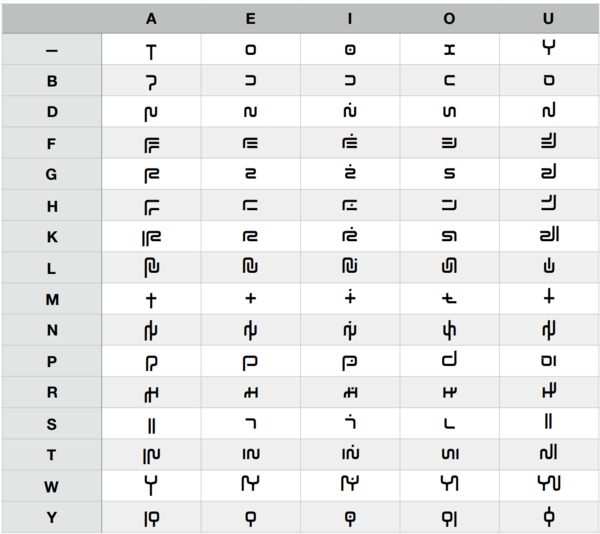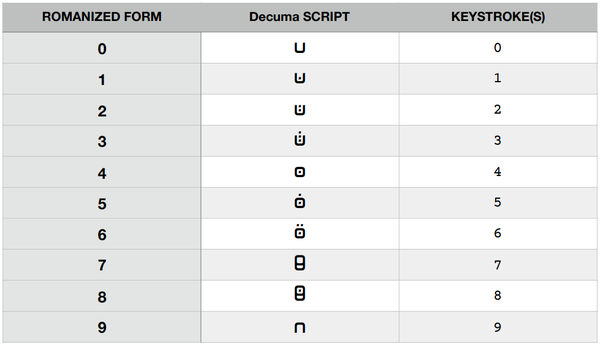Appendix:Dekuma orthography: Difference between revisions
No edit summary |
No edit summary |
||
| (6 intermediate revisions by the same user not shown) | |||
| Line 1: | Line 1: | ||
''' | '''Dekuma''' (also known as Decuma) is a {{wl|syllabary}} for the hypothetical language of the same name. The script was created by [[David J. Peterson]] and [[Claire Ng]] for the [[Netflix]] series ''[[Another Life]]''. | ||
== | ==Dekuma script== | ||
The | The Dekuma script is a syllabary characterized by single glyphs that undergo predictable modifications to represent various syllables. To illustrate this principle, take the example of a single consonant '''C''', where the form remains identical to the '''Ce''' form. Consequently, the glyph [[File:Decu_b.png|11px|baseline]] can be read as [be] or simply [b]: | ||
[[File:D1.png|600px]] | [[File:D1.png|600px]] | ||
| Line 16: | Line 16: | ||
===Numerals=== | ===Numerals=== | ||
The numerals of | The numerals of Dekuma are summarized in the following table: | ||
[[File:D4.png|600px]] | [[File:D4.png|600px]] | ||
Dekuma numerals are typically typed from left to right. Rather than relying on punctuation, a small space serves to separate hundreds from thousands and so forth: | |||
[[File:D5.png|180px]] | [[File:D5.png|180px]] | ||
| Line 26: | Line 26: | ||
===Punctuation=== | ===Punctuation=== | ||
Dekuma has only a limited set of punctuation marks. These marks can be applied between words, at the end of sentences, or at either end of sentences based on visual aesthetics: | |||
[[File:D6.png|600px]] | [[File:D6.png|600px]] | ||
[[Category: | [[Category:Dekuma script| ]][[Category:Script appendices]] | ||
Latest revision as of 00:55, 27 July 2024
Dekuma (also known as Decuma) is a syllabary for the hypothetical language of the same name. The script was created by David J. Peterson and Claire Ng for the Netflix series Another Life.
Dekuma script
The Dekuma script is a syllabary characterized by single glyphs that undergo predictable modifications to represent various syllables. To illustrate this principle, take the example of a single consonant C, where the form remains identical to the Ce form. Consequently, the glyph ![]() can be read as [be] or simply [b]:
can be read as [be] or simply [b]:
In addition to these basic syllable glyphs, vowel glyphs appear in a raised form when they follow another vowel. These raised vowel glyphs are reduced in size:
When a word begins with a vowel, a separate vocalic glyph is used. The following table demonstrates the combinations of every consonant and vowel, including these stand-alone glyphs for initial vowels:
Numerals
The numerals of Dekuma are summarized in the following table:
Dekuma numerals are typically typed from left to right. Rather than relying on punctuation, a small space serves to separate hundreds from thousands and so forth:
Punctuation
Dekuma has only a limited set of punctuation marks. These marks can be applied between words, at the end of sentences, or at either end of sentences based on visual aesthetics:





